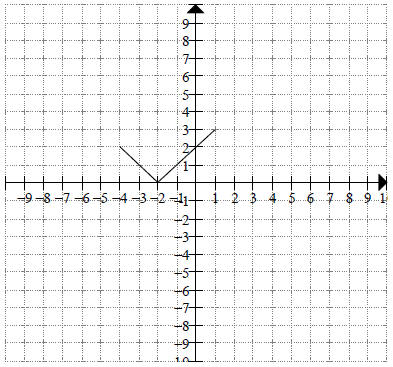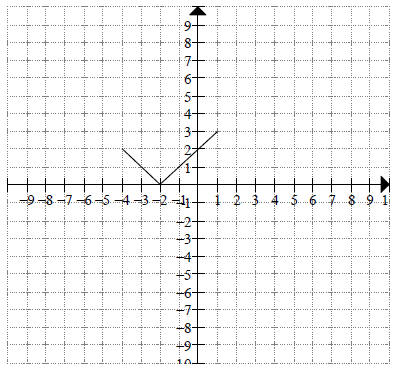Synthetic Division
Show all necessary work. The test is worth 106 points.
For problems 1-6, use f(x) = 8x – 13 and g(x) = x2 – 5. (5 points each)
1. (f + g) (-2) = __________ 4. (f – g) (3) = __________
2. (fg) (2) = __________ 5. (f ◦ g) (1) = __________
3. (g ◦ f) (1) = __________ 6. f-1(x) = __________
(4 points each) For problems 7 and 8, given the graph of y = f(x), sketch the graph of:
7. y = f(x + 2) + 3

8. y = -2 f(x)

9. Let f(x) = 2x2 + 8x – 5.
a) (5 points) Find the vertex.
b) (5 points) Write f(x) in shifted form.
10. Let f(x) = 3x3 – 7x2 – 22x + 8.
a) (5 points) Use the Rational Zero Theorem to list all possible rational
zeroes of f(x).
b) (5 points) Find all of the zeroes of f(x). Use synthetic division if necessary.
c) (4 points) Write f(x) in factored form.
11. (8 points) Let f(x) = x3 + 5x2 – 3x – 27. Given that
x = -3 is a zero of this
polynomial, use synthetic division and the quadratic formula to find the other
two zeroes.
Multiple Choice (4 points each) Choose the best response.
12. Let f(x) be a one-to-one function with domain
 What is
What is
 ?
?
a) 5 b) -5 c) − 1/5 d) cannot be determined
13. Let f(x) = 2x2 – 11x – 40. Find the axis of symmetry.

14. Let f(x) = 2x2 – 11x – 40. Find the x-intercepts.
a) (-2.5, 0) and (8, 0) c) (2.5, 0) and (-8, 0)
b) (2.5, 0) and (8, 0) d) (-2.5, 0) and (8, 0)
15. When a polynomial f(x) is divided by x – 4 using
synthetic division, the last line
of the synthetic division is:

What is the quotient?
a) 2x6– 3x5 + 5x4 + 4x3 + 11x2 – x + 2
b) 2x5 – 3x4 + 5x3 + 4x2 + 11x
– 1
c) cannot be determined because we don't know f(x)
16. When a polynomial f(x) is divided by x + 3 using
synthetic division, the last line
of the synthetic division is:

What is f(-3)?
a) cannot be determined b) 8 c) 7
because we don't know f(x)
Use f(x) = -3 (x + 2)5 (x – 1)6(x – 5)2 (2x + 3)2 for problems 17-20.
17. The degree of this polynomial is:
a) 2 b) 5 c) 6 d) 15
18. The leading coefficient of this polynomial is:
a) -3 b) 6 c) -12 d) -6
19. When graphing this polynomial:
a) the left "arm" will go up and the right "arm" will go down
b) the left "arm" will go down and the right "arm" will go up
c) both "arms" will go up
d) both "arms" will go down
20. The graph of this polynomial will:
a) "bounce" at one zero and "cross" at three zeroes
b) "bounce" at three zeroes and "cross" at one zero
c) "bounce" at all four zeroes
d) "cross" at all four zeroes


